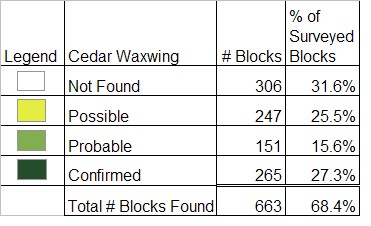Breeding Bird Atlases (BBA)
Find a Bird - BBA1
Breeding Bird Atlas 1 Species Accounts
Cedar Waxwing
Bombycilla cedrorum
Egg Dates
May 30 to August 13
Number of Broods
one; possibly sometimes two

The occurrence of Cedar Waxwings throughout the year in Massachusetts is notoriously erratic. They breed throughout the state but are not evenly distributed. Nesting is widespread in the highlands of the western sections and, to a lesser extent, in the central uplands. The distribution in the coastal plain is more spotty, local, and often irregular from year to year. During the Atlas period, portions of Cape Cod and Bristol County had the fewest reported nest confirmations.
Wandering flocks of this species may be present in the state at any time, but it is generally believed that the individuals that breed here arrive in late May or June and that those seen earlier are northbound migrants. However, waxwings do not adhere strictly to any regular migration schedule and often do not nest immediately following their arrival. More confusion results from the fact that waxwings tend to form small feeding flocks even while they are breeding.
Cedar Waxwings occur in open scrub, old pastures, second-growth woods, orchards, gardens, and along the edges of waterways, but they avoid the open expanses of large fields and marshes as well as forest interiors. Though they are well-marked, distinctive birds, waxwings can be difficult to see in the foliage, at which time their thin, wheezy calls are often the best indication of their presence. These calls are high, lisping hisses represented as see, see or ssse, sssee. A quiet song of mellow full notes has been described but it is rarely heard.
Cedar Waxwings are late nesters, often not beginning to nest until midsummer. Courtship behavior includes wing quivering and food begging by the female, as well as bill rubbing and an exchange of berries between the sexes. This exchanging of berries from one bird to another is also seen at other times of the year and often involves several members of a flock.
Nests are typically located in orchards, in shade trees, at forest edges, or in suburban plantings. They tend to be on horizontal branches of either coniferous or deciduous trees, and often range from 4 to 40 feet off the ground. Cedar Waxwing nests are built by both sexes in 5 to 7 days, and are usually bulky and rough on the outside. They are composed of twigs, weed stems, strips of bark, down, plant fibers, leaves, and fine rootlets, and often lined with hair or wool.
Three to five dull bluish eggs spotted with brown and black are laid in midsummer and are incubated primarily by the female for 12 to 14 days. After hatching, the young are tended by both parents and are fed mostly insects when they are small, but berries are included in their diet by the time they are several days old. The young ordinarily fledge in 14 to 16 days, with the latest date for a nestling in Massachusetts being September 19 (EHF).
There are conflicting reports in the literature about the number of broods reared in a season, and this has not been well studied in Massachusetts, but the extended nesting period would certainly allow for pairs to rear two broods. Forbush actually mentions one case of a reported third brood, but this is probably unusual.
After nesting in late summer and early fall, sizeble flocks of Cedar Waxwings, fattening on fruit, roam the countryside and may visit suburban gardens. Maximum counts on the coastal plain occur in this season, and the flocks undoubtedly include migrants from the north. When food is superabundant, gluttony to the point of death has been described in this species; and stories of waxwings becoming intoxicated from eating fermented fruit are often quoted. Improbable as this seems, it does actually occur. After the fall molt, the young lose their breast streaks and resemble the adults.
During the winter, variable numbers of waxwings may show up anywhere in the state. They concentrate in sites where fruit remains on the trees, often traveling long distances in search of favorable areas. In this season, a careful search of the flocks may reveal one or more individuals of their rarer, wintering relative, the Bohemian Waxwing.
Map Legend and Data Summary
Atlas 1 data collected from 1975-1979


Note: common in brushy fields, forest openings, and suburban settings
Norman P. Hill



